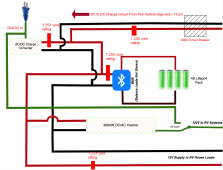PrivatePIlot
New Member
- Joined
- Nov 26, 2022
- Messages
- 33
I'm in the final stages of building a 280ah LIfepo4 system.
BMS is a JK 200A with all the goodies, high and low temp cutoff, full programable, 2a balancing, etc.
I'm still a bit foggy on the technicalities of charging, and it's the last piece of the puzzle. Can someone answer the following questions for me please?
- Since I have a BMS I do not need a "special" LifePo4 charger since the BMS will keep things safe and managed, correct? I just need something that supplies the correct voltage (see next questions), at whatever amperage I want to charge at, right?
- The biggest bang for the buck (Cost vs amp output) seem to be automotive style chargers that support AGM which gets the voltage rates up higher to the levels that will achieve a 100% SOC on Lifepo4. Any reason I shouldn't opt for this if in the end since I already own one of these?
- Alternately I've found some switching power supplies in the 30-60A range that put out either 15v or 13.5V. 15V is too high, correct? Or will the BMS be OK with that and lower the voltage going to the battery? Or will it just kick off due to over voltage?
- 13.5V is safe but will not achieve a full 100% SOC, correct? What kind of SOC will I achieve using a 13.5V power supply for charging? I see different information online about 13.5v charging being enough to get a Lifepo4 to mid 90% SOC's, is this true? If so, this fits my needs just fine as I'm not looking to stress the pack anyways, a few lost AH's for added longevity is fine with me.
Thanks for all the advice!
BMS is a JK 200A with all the goodies, high and low temp cutoff, full programable, 2a balancing, etc.
I'm still a bit foggy on the technicalities of charging, and it's the last piece of the puzzle. Can someone answer the following questions for me please?
- Since I have a BMS I do not need a "special" LifePo4 charger since the BMS will keep things safe and managed, correct? I just need something that supplies the correct voltage (see next questions), at whatever amperage I want to charge at, right?
- The biggest bang for the buck (Cost vs amp output) seem to be automotive style chargers that support AGM which gets the voltage rates up higher to the levels that will achieve a 100% SOC on Lifepo4. Any reason I shouldn't opt for this if in the end since I already own one of these?
- Alternately I've found some switching power supplies in the 30-60A range that put out either 15v or 13.5V. 15V is too high, correct? Or will the BMS be OK with that and lower the voltage going to the battery? Or will it just kick off due to over voltage?
- 13.5V is safe but will not achieve a full 100% SOC, correct? What kind of SOC will I achieve using a 13.5V power supply for charging? I see different information online about 13.5v charging being enough to get a Lifepo4 to mid 90% SOC's, is this true? If so, this fits my needs just fine as I'm not looking to stress the pack anyways, a few lost AH's for added longevity is fine with me.
Thanks for all the advice!
Last edited:




